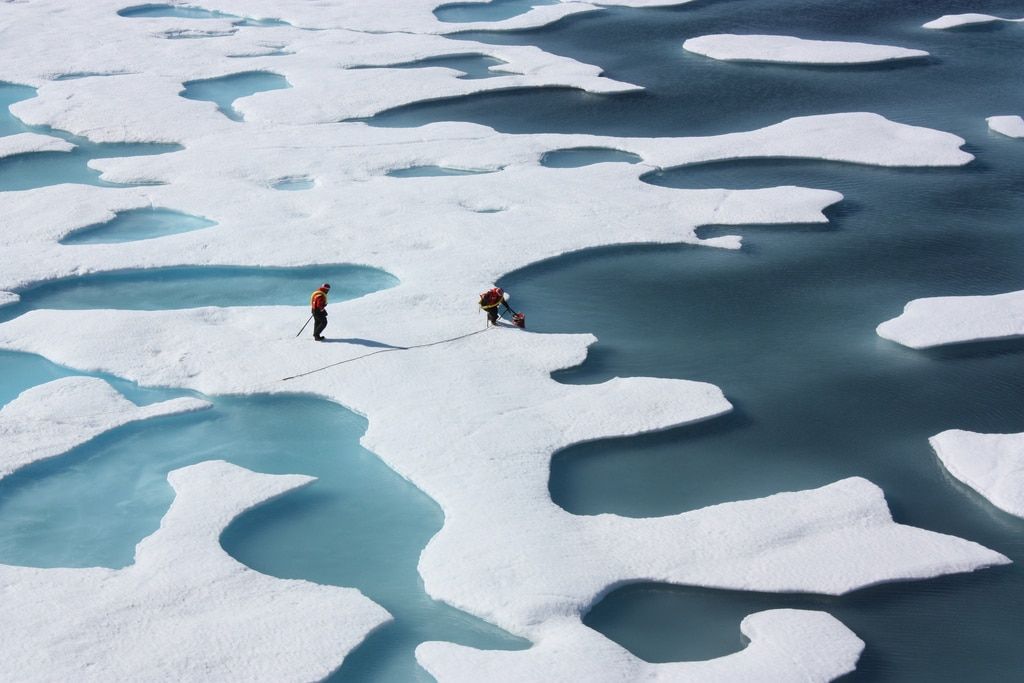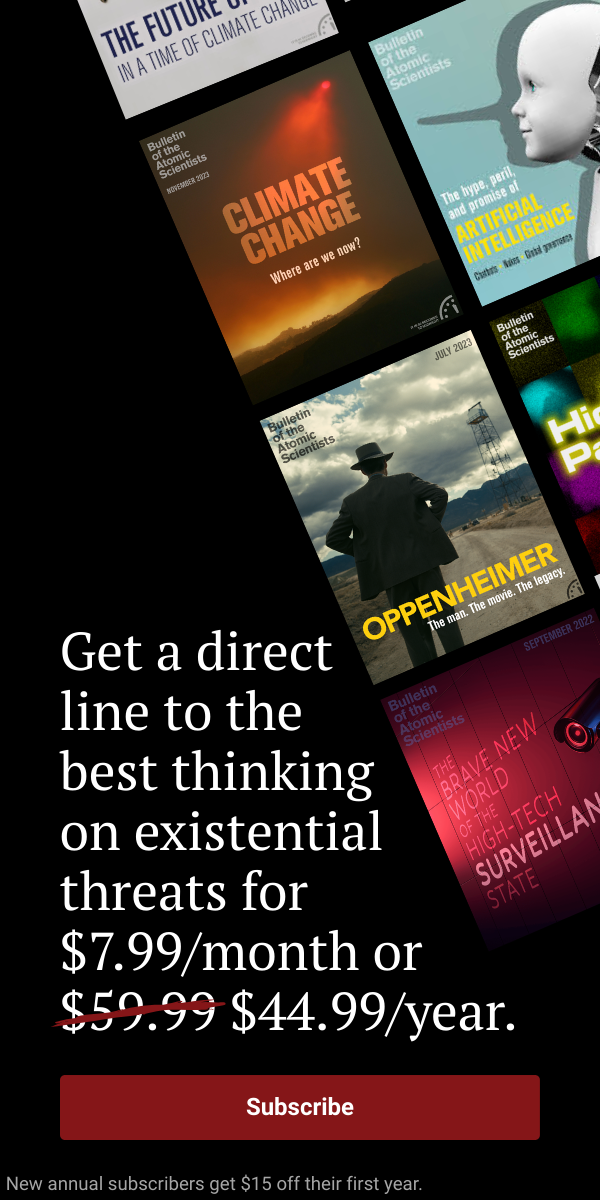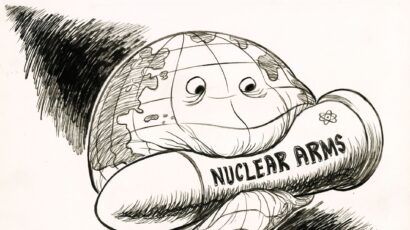Faster than forecast, climate impacts trigger tipping points in the Earth system
By David Spratt | April 19, 2023
 Melt ponds on top of sea ice in the Arctic Ocean. The Arctic has warmed nearly four times faster than the rest of the globe since 1979. (NASA image acquired July 12, 2011)
Melt ponds on top of sea ice in the Arctic Ocean. The Arctic has warmed nearly four times faster than the rest of the globe since 1979. (NASA image acquired July 12, 2011)
“Could anthropogenic climate change result in worldwide societal collapse or even eventual human extinction? At present, this is a dangerously underexplored topic … yet there are ample reasons to suspect that climate change could result in a global catastrophe,” wrote the eminent Australian climate scientist Will Steffen and his colleagues in August 2022 in “Climate Endgame: Exploring catastrophic climate change scenarios.”
Steffen, who died earlier this year, will be remembered for some of the big, crucial ideas he contributed to the understanding of the Earth system, particularly planetary boundaries, tipping point vulnerabilities and cascades, risk and nonlinearity, and the “hothouse Earth” scenario—ideas developed with Tim Lenton, Johan Rockström, Katherine Richardson, Hans Joachim Schellnhuber, and others.
In their 2018 “hothouse” paper, Steffen and his colleagues explored the potential for self-reinforcing feedbacks to push the Earth System toward a planetary threshold that, if crossed, “could prevent stabilization of the climate at intermediate temperature rises and cause continued warming on a ‘Hothouse Earth’ pathway even as human emissions are reduced.”
This challenged the notion that climate warming was a predictable, linear consequence of increasing levels of greenhouse gases, and instead pointed to critical thresholds, or tipping points, in which a small change causes a larger, more critical change to be initiated, taking the climate system as a whole or particular systems within it from one state to a discretely different state. The loss of polar glaciers, or the Amazon rainforest drying and being replaced by sclerophyll forest, are examples.
The change may be abrupt or non-linear—characterized by sudden change rather than smooth progress—and irreversible on relevant time frames.
It may also lead to cascading events in which the mutual interaction of individual climate tipping points and/or abrupt changes lead to more profound changes to the entire system. This is already happening. The loss of sea ice in the Arctic is adding to regional warming, accelerating ice melt from Greenland, such that an influx of cold, non-salty water into the North Atlantic is slowing the Gulf Stream, which in turn is changing the Amazon climate.
Recent research has confirmed that tipping points and cascades are already occurring, not at 1.5 or 2 degrees Celsius of warming, but right now. In one of his last published pieces, a 2022 book chapter, Steffen said, “it is clear from observations of climate change-related impacts in Australia alone—the massive bushfires of the 2019-2020 Black Summer, the third mass bleaching of the Great Barrier Reef in only five years, and long-term cool-season drying of the country’s southeast agricultural zone—that even a 1.1°C temperature rise has put us into a dangerous level of climate change.”
While observed warming has been close to climate model projections, the impacts have in many instances been faster and even more extreme than the models forecasted. William Ripple and his co-researchers show that many positive feedbacks are not fully accounted for in climate models.
And prominent climate scientist Michael Mann says that when it comes to certain important consequences of warming, including ice sheet collapse, sea level rise, and the rise in extreme weather events, “the [Intergovernmental Panel on Climate Change (IPCC)] reports in my view have been overly conservative, in substantial part because of processes that are imperfectly represented in the models.”
In September 2022, Stockholm University’s David Armstrong McKay and his colleagues concluded that even global warming of 1-degree Celsius risks triggering some tipping points, just one data point in an alarming mountain of research on tipping points presented in the last year and a half.
Denman Glacier, in East Antarctic, was identified as susceptible to collapse of its ice shelf and inundation of the glacier itself, which sits on a retrograde base below sea level. Scientists announced that the Thwaites Glacier ice shelf in West Antarctica was fracturing and likely to result in a speeding up of the glacier’s flow and ice discharge, possibly heralding the collapse of the glacier itself and triggering similar increases across the Amundsen Sea glaciers. “The final collapse of Thwaites Glacier’s last remaining ice shelf may be initiated … within as little as five years,” they said.
In November 2022, the State of the Cryosphere report concluded that more than four meters of additional sea level rise was locked in “with sections of the West Antarctic ice sheet potentially collapsing even without any further emissions over the coming centuries.” An ingenious look at the genetic history of Turquet’s octopus and its population movement across Antarctica in past warm periods led to the conclusion that “even under global heating of 1.5°C—the most ambitious goal under the global Paris climate agreement—the West Antarctic Ice Sheet could be consigned to collapse.”
In August, researchers showed that the Arctic has warmed nearly four times faster than the globe since 1979 and concluded it is likely climate models systematically tend to underestimate this amplification. A few months later, scientists reported that Greenland Ice Sheet glaciers are melting 100 times faster than previously calculated. At the end of 2021, Professor Jason Box said that the Greenland Ice Sheet has passed a tipping point: “Technically, now [at 1.2°C] Greenland is beyond its viability threshold… 1.5°C would mean the ‘beyond the threshold’ state is enhanced and the loss [of ice mass] becomes a complex, non-linear, amplified response guaranteeing the ice sheet remains beyond its viability threshold.”
Permafrost carbon emissions and the feedback loops they will initiate are not accounted for in most Earth system models or Integrated Assessment Models, including those which informed the IPCC’s special report on global warming of 1.5 degrees Celsius, nor are they fully accounted for in global emissions budgets. If carbon-cycle feedbacks such as tipping points in forest ecosystems and abrupt permafrost thaw are accounted for, the estimated remaining budget for carbon emissions could disappear altogether.
In a ground-breaking 2021 paper, Northern Arizona University’s Katharyn Duffy and colleagues mapped the relationship between increasing temperatures and carbon uptake in Amazon forests by analyzing more than 20 years of data on the transfer of carbon dioxide between plants, land, and the atmosphere; their analysis showed that in recent hot periods the thermal maximum for photosynthesis had been exceeded. At higher temperatures, the amount of carbon dioxide absorbed by plants (photosynthesis) will decline sharply, whilst carbon dioxide released by plants (respiration) will continue to rise.
In addition, recent evidence shows human fossil fuel emissions are still rising and will not likely plateau until the end of this decade, a far cry from the “carbon law,” which requires halving emissions by 2030 to keep warming to under a 2-degree Celsius trajectory. Current analysis suggests the world is heading to around 3 degrees Celsius of warming, or perhaps 3.5 degrees Celsius in a plausible high-end trajectory.
There are fair and reasonable concerns that focusing on worst-case scenarios will cause public despair and paralysis. But when risks are existential, it is precisely those high-end possibilities of system collapse, rather than the middle-of-the-road linear probabilities, that must be the focus of concern and should spur the world to action.
Speaking in 2018, Steffen said that the dominant linear, deterministic framework for assessing climate change is flawed, especially at higher levels of temperature rise. Model projections that don’t include these feedback and cascading processes “become less useful at higher temperature levels… or, as my co-author John Schellnhuber says, we are making a big mistake when we think we can ‘park’ the Earth System at any given temperature rise – say 2°C – and expect it to stay there.”
Together, we make the world safer.
The Bulletin elevates expert voices above the noise. But as an independent nonprofit organization, our operations depend on the support of readers like you. Help us continue to deliver quality journalism that holds leaders accountable. Your support of our work at any level is important. In return, we promise our coverage will be understandable, influential, vigilant, solution-oriented, and fair-minded. Together we can make a difference.
Keywords: Hothouse Earth, climate crisis, global warming, tipping points
Topics: Climate Change
















Many people fail to understand what tipping points imply. Some assume that we can still recover from them. Many, with technical backgrounds, prefer to believe that humans are so ingenious and creative that it will never be too late to intervene to reverse a cascading trend. Typically they reject the concept that our species is rapidly heading towards extinction.
I fully agree. I lived in the Arctic for over 10 years up to 2001. I saw drastic changes to the tundra ecosystem. Extreme permafrost meltdown with the smell of methane gas. I witnessed buildings sinking, houses with cracked walls with doors hanging on crooked frames. I saw birds and animals that were not present in the early 1980s. I wrote about this and how fast we are heading towards a global ecosystem collapse …..
I studied at McGill University in the Environmental Sciences and graduated in 1978.
It’s been obvious for 2-3 years that multiple tipping points have already been breached. The flawed climate models and the IPCC reports based on them do humanity a disservice and are actually helping to accelerate our demise. Even after UN Secretary General Gutteres announced “Code Red for Humanity” not a single “world leader” stepped forward to respond and to provide leadership to an anxious public. This is unacceptable. Instead of all the mealy mouth, politically correct language, the scientists, the IPCC, and the politicians need to start telling it like it is. It is extremely bad and we are certainly… Read more »
The climate models are fine overall, except that they are not up to speed on aerosols. The IPCC reports final version must be approved by all member nations, so political influence tempers the outlook so that it is not as alarmist as it should be. This rogue species will still be causing problems on this planet in 2030 and beyond, but Nature must find a way to reign it in.
A couple of months ago, when the atmospheric rivers were dumping on California for weeks, the Wall Street Journal ran a front page article never once referencing climate change, just citing statistics showing them to be normal. The comments posted by readers were just sophomoric stabs at liberals and scientists. No intelligent conversation, truly sad.
This is not news- read Dr. James Hansen’s 2009 book: Storms of My Grandchildren and the section on “Venus Syndrome” describing the runaway conditions that WILL start when the ocean’s methyl hydrates get warmed, and now, with proposed sea-bed mining, that problem is increased by orders of magnitude. This warming starts as the overturning ocean currents from the polar areas are replaced by warm salty water in mid-Pacific sinking to the bottom. This is NOT “climate change,” it is a planetary catastrophe. see https://kathleenmccroskey.substack.com/p/this-is-not-climate-change
I have had a particular interest in the permafrost melt since 2018. I am not a climate scientist though one known to me basically verified my findings, such was they were, as genuine a few months ago. Reporting of permafrost melt is something that in so many forums seems to lack detail. About half the permafrost is already melted. Methane-emitting thermokarst lakes can be seen to the horizon in large areas now. The dead carcasses and vegetation in the melted permafrost at the bottom of these lakes are being decomposed by bacteria respiring anaerobically, since there is no oxygen under… Read more »